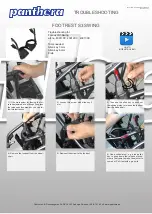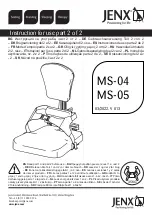
SECTION 2—SAFETY INSPECTION/TROUBLESHOOTING
28
SECTION 2—SAFETY INSPECTION/
TROUBLESHOOTING
NOTE:
Every
six
months
take
your
wheelchair
to
a
qualified
technician
for
a
thorough
inspection
and
servicing.
Regular
cleaning
will
reveal
loose
or
worn
parts
and
enhance
the
smooth
operation
of
your
wheelchair.
To
operate
properly
and
safely,
your
wheelchair
must
be
cared
for
just
like
any
other
vehicle.
Routine
maintenance
will
extend
the
life
and
efficiency
of
your
wheelchair.
Safety Inspection Checklists
Initial
adjustments
should
be
made
to
suit
your
personal
body
structure
needs
and
preference.
Thereafter
follow
these
maintenance
procedures:
Inspect/Adjust Initially
CAUTION
As with any vehicle, the wheels and tires should be checked periodically for cracks
and wear, and should be replaced.
❑
Ensure
wheelchair
rolls
straight
(no
excessive
drag
or
pull
to
one
side).
❑
Inspect
clothing
guards
for
bent
or
protruding
metal.
❑
Ensure
that
all
fasteners
on
clothing
guards
are
secure.
❑
Ensure
arms
are
secure
but
easy
to
release
and
adjustment
levers
engage
properly.
❑
Ensure
adjustable
height
arms
operate
and
lock
securely.
❑
Ensure
armrest
upholstery
has
no
rips.
❑
Ensure
armrest
pad
sits
flush
against
arm
tube.
❑
Ensure
hand
grips
are
not
loose.
❑
Ensure
seat,
back
and/or
arm
upholstery
have
no
rips.
❑
Ensure
trigger
release
lever
cables
and
handles
return
when
released.
❑
Inspect
handrims
for
signs
of
rough
edges
or
peeling
finish.
❑
Ensure
there
is
no
excessive
side
movement
or
binding
when
drive
wheels
are
lifted
and
spun.
❑
Ensure
sealed
bearings
and
axle
nut
tension
are
correct.
❑
Adjust
bearing
system
if
wheel
wobbles
noticeably
or
binds
to
a
stop.
❑
Ensure
wheel/fork
assembly
has
proper
tension
when
caster
is
spun.
Caster
should
come
to
a
gradual
stop.
❑
Loosen/tighten
caster
locknut
if
wheel
wobbles
noticeably
or
binds
to
a
stop.
❑
Ensure
all
caster/wheel/fork/headtube
fasteners
are
secure.
















































